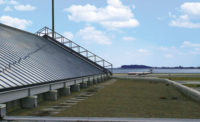Mazama, Washington
Record Houses 2008
Glenburn House ![]() H16
H16 ![]() Maltman Bungalows
Maltman Bungalows ![]() Palmyra House
Palmyra House ![]() The Rolling Huts
The Rolling Huts ![]() Wall House
Wall House ![]() Dairy House
Dairy House ![]() Nora House
Nora House ![]() VH r-10 gHouse
VH r-10 gHouse
While Henry David Thoreau’s solitary sojourn at Walden Pond lasted two years, two weeks, and two days, it took Michal Friedrich, owner of Delta Shelter, also known as Stilt Cabin [RECORD, April 2006, page 92], in Mazama, Washington, only a year and a half to realize he wanted visitors to his secluded mountain retreat. To accommodate them, he commissioned the same architect who designed Delta Shelter—Tom Kundig, FAIA, of Olson Sundberg Kundig Allen Architects—to design six Rolling Huts. The huts, set on short, wheeled legs, look like the baby chicks of Mother Delta, with the same rudimentary, pared-down style and materials, a treatment that speaks to Thoreau’s philosophy of self-reliance and simplicity, which Kundig has admired since his youth.
The owner’s cabin and the huts perch on a high-altitude flood-plain meadow in the Methow Valley, a 40-acre plot in the tiny village of Mazama in Washington State’s Cascade Mountains, an area covered with Douglas fir and Ponderosa pine. There are no ski lifts here; instead, it is home to one of the world’s longest cross-country ski trails and a place for deep-snow helicopter skiing. In this high-desert elevation, cold winters follow the intense heat and aridity of summer. Such a climate helped determine Kundig’s choice of materials for Rolling Huts—steel, plywood, and car-decking on the exterior; cork and plywood on the interior. The raw materials at once respond to the rugged setting, allow natural weathering, and require almost no maintenance.
“In Sun Valley, I saw Basque huts on wheels that looked like covered wagons that people parked on their properties to accommodate visitors,” says Kundig, explaining in part the origin of his idea. That the property was licensed for 14 parking stalls for recreational vehicles (RVs), allowing Kundig to construct the buildings on wheels and get permits for them as RVs, also contributed to the plan. In addition, the huts’ wheeled underbellies raise the dwelling units high enough to offer 360-degree views of the surrounding landscape, in much the same way that Delta Shelter’s thin columns elevate it. Lastly, lifting the huts above ground preserved the meadow terrain, which had been damaged by 80 years of overgrazing by horses. Each of these gestures reveals the architect’s and owner’s mutual desire to create a highly sustainable and noninvasive ecodevelopment.
While the huts look toward Goat Peak Mountain in the north and west through double-paned, low-E sliding-glass doors, steel walls on the back and side establish privacy from the other members of the “herd,” as Kundig calls the group. In Japan, windows often look onto private gardens and away from neighboring houses, recalls Friedrich. “You know there are other people around, but you can’t see them.” Kundig’s design exercises a similar response to the need for privacy.



Post a comment to this article
Report Abusive Comment